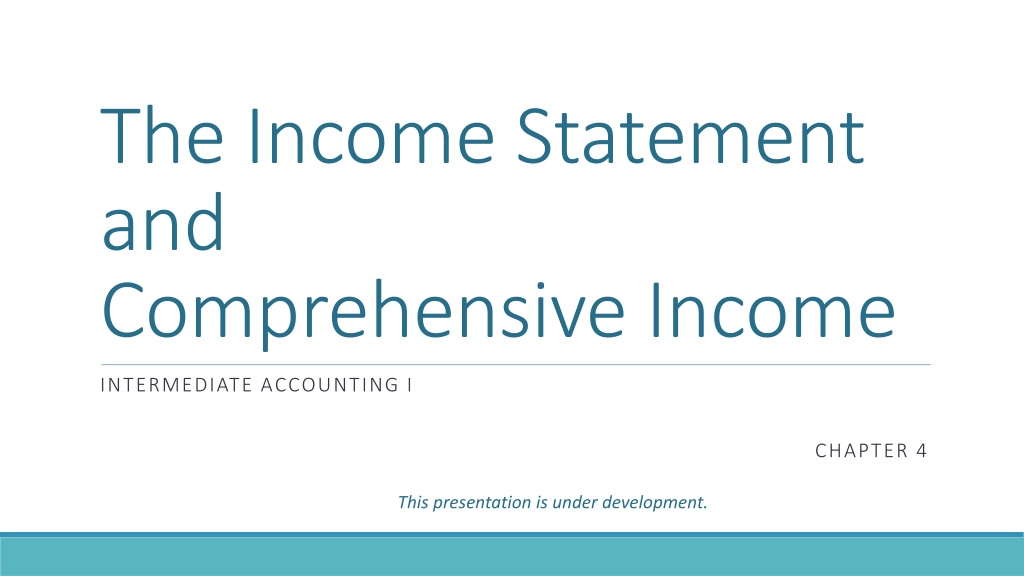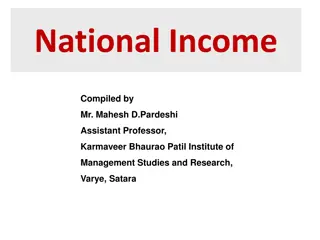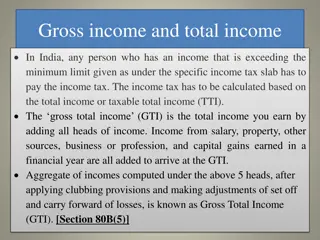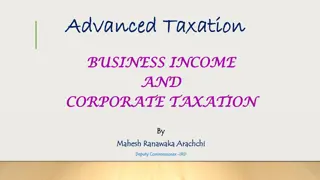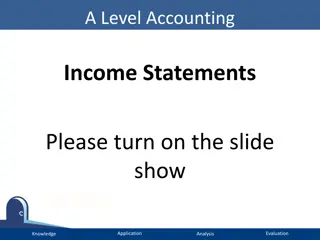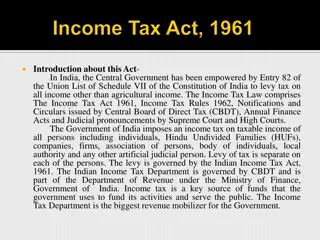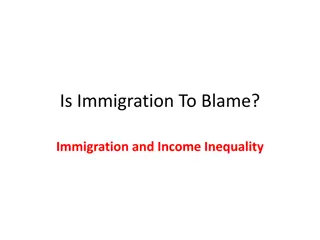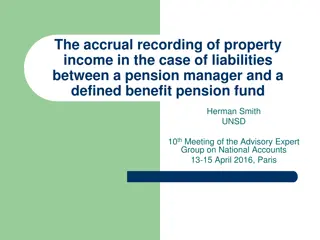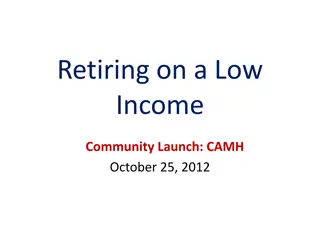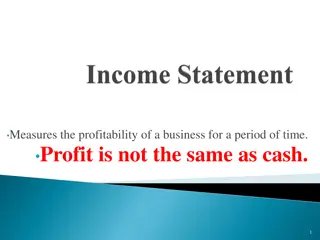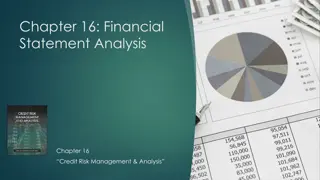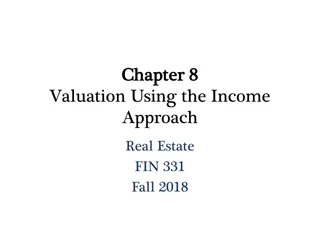Understanding Income Statements and Their Types
Income statements are crucial financial documents that showcase a company's operating performance. Single-step income statements group all revenues and expenses together for simplicity, while multiple-step statements provide intermediate subtotals for better analysis. The presentation delves into the components of income statements, such as revenues, expenses, gains, and losses, and distinguishes between operating and nonoperating items. The Matching Principle, which aligns revenues and expenses in the same accounting period, is also discussed.
Download Presentation

Please find below an Image/Link to download the presentation.
The content on the website is provided AS IS for your information and personal use only. It may not be sold, licensed, or shared on other websites without obtaining consent from the author. Download presentation by click this link. If you encounter any issues during the download, it is possible that the publisher has removed the file from their server.
E N D
Presentation Transcript
The Income Statement and Comprehensive Income INTERMEDIATE ACCOUNTING I CHAPTER 4 This presentation is under development.
INCOME STATEMENT The income statement displays a company s operating performance during a particular reporting period. Single-step lists all revenues and gains grouped together and all expenses and losses grouped together. The advantage of the single-step income statement is simplicity of preparation Multiple-step includes a series of intermediate subtotals An advantage of the multiple-step income statement is that it separates operating and nonoperating items and allows for better analysis of income and expense items.
Single-step Income Statement MAXWELL GEAR CORPORATION Income Statement For the Year Ended December 31, 2013 Revenues and gains: Sales Interest and dividends Gain on sale of investments Total revenues and gains Expenses and losses: Cost of goods sold Office salaries Depreciation Miscellaneous Interest Total expenses and losses Income before income taxes Income tax expense Net income $573,522 26,400 5,500 605,422 $302,371 47,341 24,888 16,300 14,522 405,422 200,000 80,000 $120,000
Multiple-step Income Statement MAXWELL GEAR CORPORATION Income Statement For the Year Ended December 31, 2013 Sales revenue Cost of goods sold Gross profit Operating expenses: Selling Expenses General and Administrative Expenses Restructuring Costs Total operating expenses Operating income Other income (expense): Interest and dividend revenue Gain on sale of investments Interest expense Total other income, net Income before income taxes Income tax expense Net income $573,522 302,371 271,151 $47,341 24,888 16,300 88,529 182,622 26,400 5,500 (14,522) 17,378 200,000 80,000 $120,000
The Income Statement: Income from Continuing Operations Includes revenues, expenses, gains, and losses that will probably continue in future periods. Revenue inflows of resources resulting from providing goods or services to customers Expenses outflows of resources incurred in generating revenue Gain increase in equity from peripheral or incidental transactions Loss decrease in equity from peripheral or incidental transactions Gross profit is Sales less Cost of Goods Sold. A distinction is often made between operating and nonoperating (other) income. Income tax expense is shown as a separate expense. Matching Principle revenues and the expenses incurred to generate those revenues should be matched together in the same accounting period.
Gains and Losses Income from Continuing Operations Includes revenues, expenses, gains, and losses that will probably continue in future periods. Gross profit is Sales less Cost of Goods Sold. Income tax expense is shown as a separate expense. A distinction is often made between operating and nonoperating income. Revenue inflows of resources resulting from providing goods or services to customers Expenses outflows of resources incurred in generating revenue Gain increase in equity from peripheral or incidental transactions Loss decrease in equity from peripheral or incidental transactions
Operating vs. Nonoperating Income Operating Income Includes revenues and expenses directly related to the primary revenue- generating activities of the company. Sales revenue Services income Gains and losses from selling operating assets Nonoperating Income Relates to peripheral or incidental activities of the company Gains and losses from selling investments Interest Revenue and Expense
EARNINGS QUALITY The ability of reported earnings to predict a company s future earnings. To enhance predictive value, analysts try to separate a company s permanent earnings effects from its transitory earnings (result from transactions or events that are not likely to occur again in the foreseeable future.) Not all items included in operating income should be considered indicative of a company s permanent earnings. Restructuring costs include costs associated with shutdown or relocation of facilities or downsizing of operations. GAAP requires these costs to be expensed in the period(s) incurred. Asset impairment losses, inventory write-down charges, losses from natural disasters such as earthquakes and floods, and gains and losses from litigation settlements are other operating expenses that call into question the issue of earnings quality.
Restructuring Costs Costs associated with Reorganizing operations for greater efficiency Shutdown or relocation of facilities Downsizing of operations Reported as a separate line item in operating income Recognized only in the period incurred Disclosure notes should describe the situation Exercise 4-5
Earnings per Share Disclosure Earnings per share should be disclosed on the face of the income statement Calculate EPS for income from continuing operations discontinued operations net income Calculated by dividing each earnings figure by the outstanding common stock shares Brief Exercise 4-5
Discontinued Operations Involves the disposal or planned disposal of a component of an entity. A component is any part of the company, such as an operating segment or subsidiary, that includes operations and cash flows that can be clearly distinguished, operationally and for financial reporting purposes, from the rest of the company. Reported separately, below income from continuing operations Income tax expense or benefit is shown on a separate line 1. When the component has been sold, the income effects of a discontinued operation includes (1) the operating income or loss of the component from the beginning of the reporting period to the disposal date, and (2) the gain or loss on disposal. 2. When the component is considered held for sale, the income effects of a discontinued operation includes (1) operating income or loss of the component from the beginning of the reporting period to the end of the reporting period, and (2) an impairment loss if the book value, sometimes called carrying value or carrying amount, of the assets of the component is more than fair value minus cost to sell.
Discontinued Operations - Sample Problem A The Duluth Holding Company has several operating divisions. In October 2016, management decided to sell one of its divisions that qualifies as a separate component according to generally accepted accounting principles. The division was sold on December 18, 2016 for a net selling price of $14,000,000. On that date, the assets of the division had a book value of $12,000,000. For the period January 1 through disposal, the division reported a pre-tax loss from operations of $4,200,000. The company s income tax rate is 40% on all items of income or loss. Duluth generated after-tax profits of $22,350,000 from its continuing operations. Income from continuing operations Discontinued operations: Loss from operations of discontinued component Income tax benefit Loss on discontinued operations Net income $22,350,000 (2,200,000) 880,000 (1,320,000_ $21,030,000
Discontinued Operations - Sample Problem B The Duluth Holding Company has several operating divisions. In October of 2016, management decided to sell one of its divisions that qualifies as a separate component according to generally accepted accounting principles. On December 31, 2016, the end of the company s fiscal year, the division had not yet been sold. On that date, the assets of the division had a book value of $12,000,000 and a fair value, minus anticipated costs to sell, of $9,000,000. For the year, the division reported a pre-tax loss from operations of $4,200,000. The company s income tax rate is 40% on all items of income or loss. Duluth generated after-tax profits of $22,350,000 from its continuing operations. Income from continuing operations Discontinued operations: Loss from operations of discontinued component Income tax benefit Loss on discontinued operations Net income Book Value Loss from operations of Discontinued Component $22,350,000 (7,200,000) 2,880,000 Discontinued Segment Operating Loss Impairment Loss Fair Value $4,200,000 (4,320,000) $18,030,000 $9,000,000 12,000,000 (3,000,000) ($7,200,000)
Other Comprehensive Income B. Comprehensive income is the total change in equity for a reporting period other than from transactions with owners. Comprehensive income includes net income. C. The information in the income statement and other comprehensive income items can be presented either (1) in a single, continuous statement of comprehensive income or (2) in two separate, but consecutive statements, an income statement and a statement of comprehensive income. (T4- 14) D.Changes in equity that are not permitted to be included in net income. Unrealized gains/losses on available-for-sale investments Unrealized gains/losses on hedge/derivative financial instruments Foreign currency translation adjustments Unrealized gains/losses on postretirement benefit plans Breaking out other comprehensive income helps to achieve the goal of predictive value. Examples of other comprehensive income include: Brief Exercise 4-9 Exercise 4-4
The Income Statement and Comprehensive Income INTERMEDIATE ACCOUNTING I CHAPTER 1 END OF PRESENTATION
